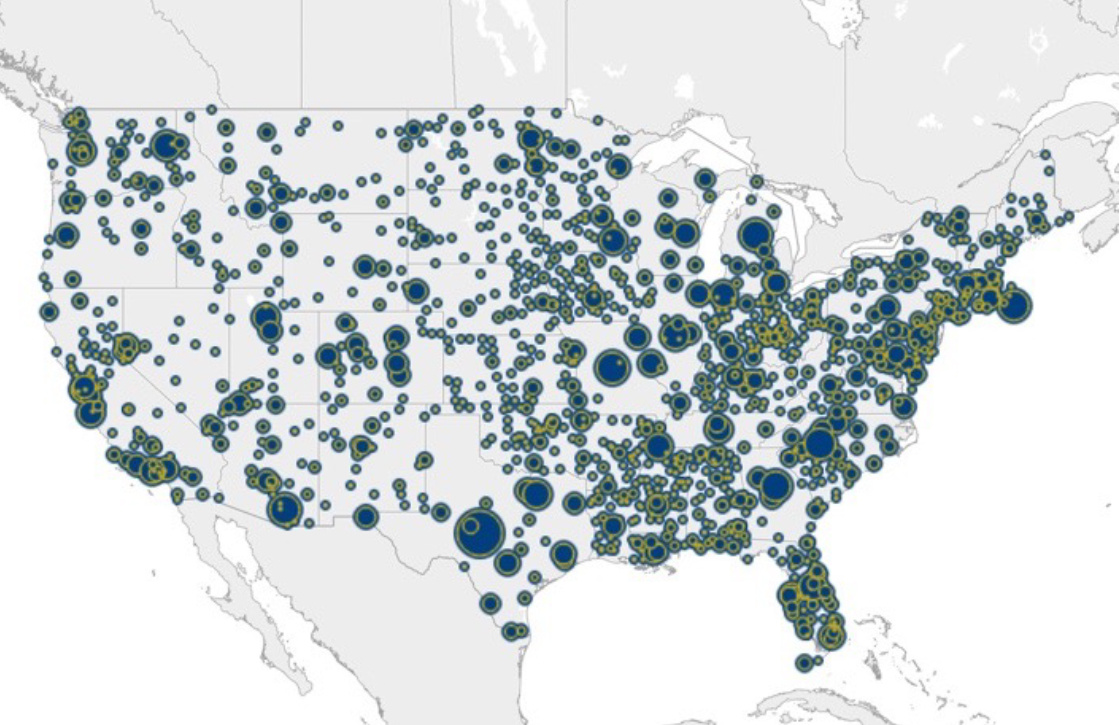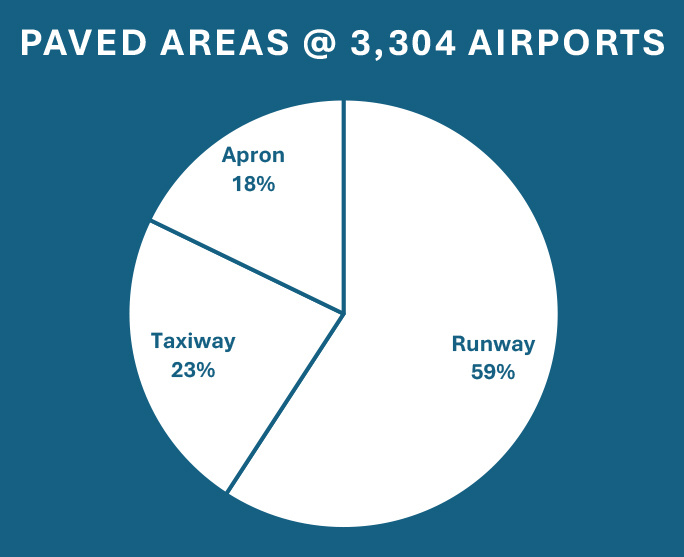
How the 2024 FAA Reauthorization Bill Impacts the Asphalt Market
Data on the asphalt pavement mix is sometimes hard to come by, but we do know this, the market for asphalt pavement at our nation’s 3,304 airports is second only to publicly funded highways, and the airfield market is growing. According to the Federal Aviation Administration (FAA), there are 19,636 airports overall, but only 3,304 are eligible to receive federal grants for capital improvements.
The federal government supports the development of airport infrastructure through the Airport Improvement Program (AIP). The AIP program provides federal grants to airports for planning and development, mainly of capital projects related to aircraft operations such as runways and taxiways. Congress also allows airports to impose a fee against enplaning passengers for the purpose of funding approved projects at that airport. The Passenger Facility Charge (PFC) program was first authorized by Congress in 1992. The total market for asphalt mix in airfield pavements is about $3 billion annually.
Last month Congress passed, and the President signed into public law H.R. 3935, Securing Growth and Robust Leadership in American Aviation Act, a bill that reauthorizes the Federal Aviation Administration (FAA) programs. Reauthorization of the FAA refers to a periodic process through which Congress develops legislation to renew authorizing statutes (e.g., the AIP Program) and revise and update relevant laws governing civil aviation programs and functions primarily carried out by the FAA. The last multiyear FAA reauthorization measure was enacted by Congress in 2018.

$3.2 billion in AIP Grants awarded in 2023. More detailed information can be found here.
H.R. 3935 authorizes continued funding for airfield pavement projects under the Airport Improvement Program (AIP) and includes funding to make asphalt airfield pavements to be more sustainable. According to the FAA, over 80% of the airfield pavements are surfaced with asphalt. Thus, any changes in funding or policies included in the legislation has an impact on the asphalt pavement industry.
Key Facts

According to FAA, there are 382 million sq/m of paved areas at the nation’s 3,304 airports, the equivalent of 56,000 lane miles.
The FAA Reauthorization Act increases AIP funding by more than $600 million annually, a whopping 19% increase. Since 2005, Congress provided $3.35 billion annually for the AIP program. Total AIP funding, which helps to finance runways, taxiways, aprons, and other airport improvements will grow to $4 billion annually starting in FY 2024 through FY 2028.
Roughly half of AIP funding is invested in airfield pavements. In addition, the Investment Infrastructure and Jobs Act (IIJA) added another $15 billion in AIP funding, over-and-above what the FAA reauthorization bill provides. Combined, H.R. 3935 and IIJA will significantly boost funding for airfield pavement projects over the next 5 years.
The other source of revenue for asphalt airfield projects is the Passenger Facility Charge (PFC) Program that Congress authorizes to allow the collection of PFC charges up to $4.50 for every eligible passenger at commercial airports controlled by public agencies. PFCs are capped at $4.50 per flight segment with a maximum of two PFCs charged on a one-way trip or four PFCs on a round trip, for a maximum of $18 total. Airports use these charges to fund FAA-approved projects that enhance safety, security, or capacity; reduce noise; or increase air carrier competition.
Since the inception of the PFC in 1992, 399 airports have been approved to collect the tax, according to the FAA. PFC collections are estimated to reach $3.6 billion in 2024. Of that amount, 17% of PFC revenues fund runway, taxiways and apron projects. The PFC was last increased in 2000. Despite efforts to increase the cap on the PFC in H.R. 3935, Congress left the cap in place.
On pavement sustainability, Congress including language in H.R. 3935 to mandate the Secretary of Transportation carryout a pavement research program to develop sustainability and resiliency guidelines focused on improving long-term pavement performance. Congress provides $6 billion annually for the program which is split 50-50 between asphalt and concrete materials. The FAA conducts research on asphalt airfield pavements at the William J. Hughes Technical Center in Atlantic City, New Jersey. In 2004, Congress established the Airport Asphalt Pavement Technology Program that resulted in a cooperative agreement between the FAA and Auburn University. Recently, FAA signed a cooperative agreement with the National Asphalt Pavement Association to manage and carryout the same program. NAPA will soon issue a request for proposals for a project to reduce carbon in asphalt airfield pavements.
H.R. 3935 established a new Airport Safety and Resilient Infrastructure Discretionary Grant Program for projects that reduce runway incursions or increase resiliency for airport infrastructure against changing flooding patterns. The bill provides $534 million in 2024 and $200 million thereafter through 2028. This is the first time AIP allows airports to use AIP funding for airport environmental resiliency projects.
FAA is slowly coming around to accepting innovation in asphalt mix materials. For example, FAA has taken steps to address resiliency in discretionary IIJA grant programs. Currently, FAA incorporates resiliency and climate change in its project selection criteria for the IIJA funded grants. However, FAA has not established a mechanism for collecting and reporting data (e.g., Environmental Product Declarations) on the extent to which IIJA-funded projects address climate and sustainability. In September 2021, FAA entered into an interagency agreement with the U.S. Department of Transportation’s John A. Volpe National Transportation Systems Center (Volpe) for a 5-year study to identify the climate change risk to airport systems.
Conclusion
The reauthorization of FAA programs follows on the heals of enactment of IIJA and the Inflation Reduction Act. All three major infrastructure bills boost funding for projects that benefit the asphalt market and steer grant recipients and the construction materials industry towards utilizing asphalt and concrete mixes that low-embodied carbon materials.
What is most interesting with H.R. 3935 is that the ranking member on the Senate Commerce Committee, Senator Ted Cruz (R-TX), no friend of the climate change movement, drafted the legislation! Senator Cruz signed-off and supported the provisions to make asphalt more sustainable. That should be a wakeup call for the asphalt pavement industry. The goal of reducing carbon in asphalt mix is a business decision that is not going away any time soon. In fact, it is here to stay.

ABOUT THE AUTHOR
Jay Hansen joined Surface Tech following a long and distinguished career at the National Asphalt Pavement Association and in the U.S. Congress where he worked on legislation from the Intermodal Surface Transportation Act (ISTEA) in 1991, to the Infrastructure Investment and Jobs Act (IIJA) in 2021. Jay will serve as an ongoing resource for Surface Tech customers to help them get ahead of the growth curve and be ready for shifting market conditions as they occur in 2023 and beyond.

